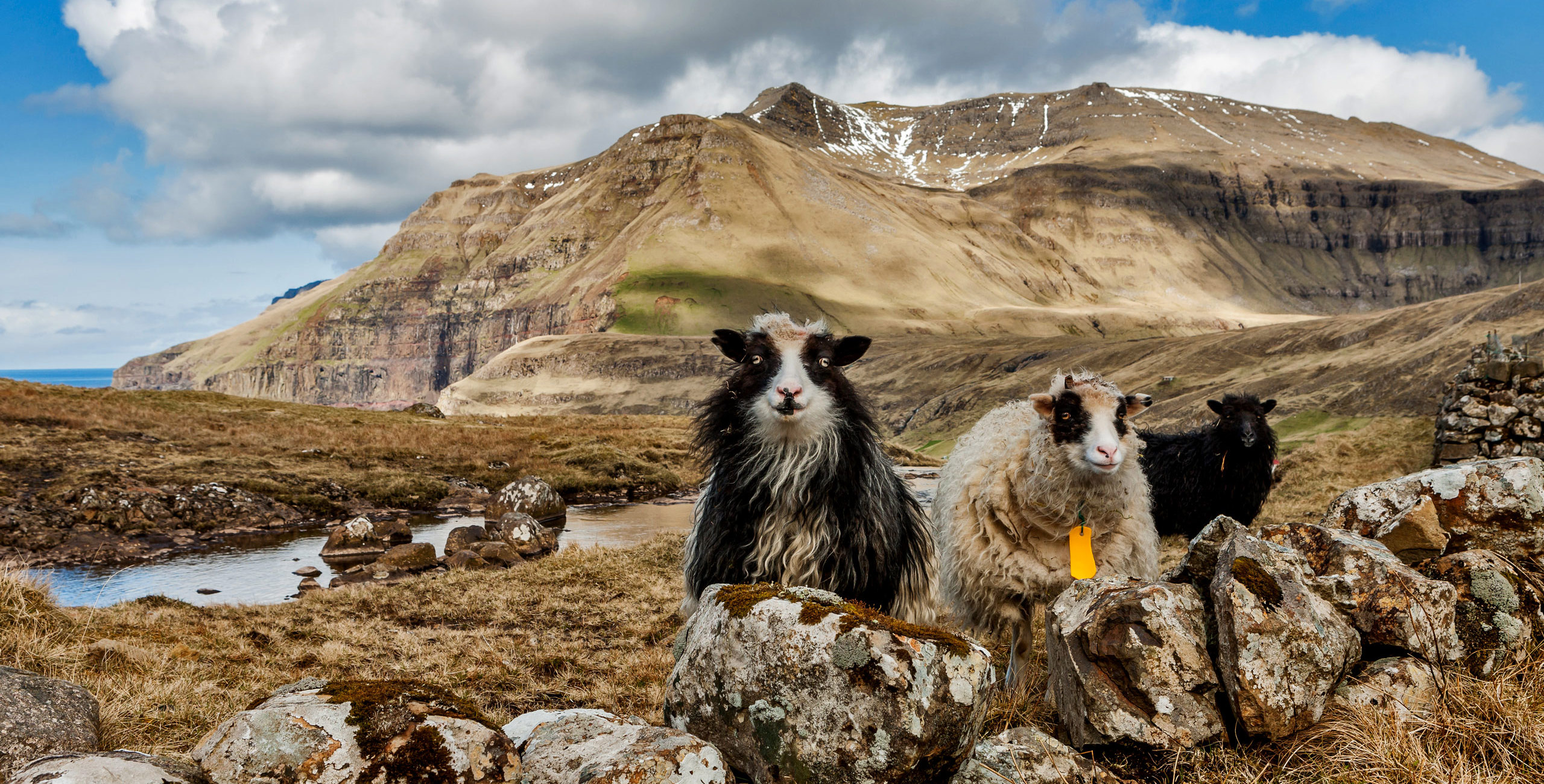
The name Føroyar (Faroe Islands) is derived from old Norse Færeyjar and literally means Sheep Islands, a name given by the Norse people that settled these rough and wind-swept isles during the Viking Age.
The Faroese Sheep
The Faroese sheep, a type of Northern European short-tailed sheep, is a small and hardy breed. They have a light, but strong, bone structure, which makes them ideal for the steep mountainous terrain, which in turn naturally provides for all their dietary needs. This breed has wool in many different colours – white, grey, light and dark red, chestnut brown and black or some mixture of thereof. The flocks divide into small groups, which range and graze across wide pasturelands. They are seasonal breeders and most commonly produce one offspring per season. The ewes weigh around 45 pounds (20 kilograms) when mature and rams weigh about 45-90 pounds (20-40 kilograms).
The origin of the Faroese breed is believed to stem from the sheep brought to the Faroese Islands by Norse settlers during the Viking age. During the 17th century, however, the number of sheep decreased to a point where it became necessary to import sheep from Iceland and the Scottish Isles. This proved favourable and during the 1840’s more Scottish sheep were brought in, to mix with the local breed. This mixture produced more meat and better wool.
What is thought to have been the last of the original Norse breed was shot in 1860 on the small and unpopulated island called Lítla Dímun. They are said to have been particularly wild and three stuffed specimens can be seen at the National Museum of the Faroe Islands.
Sheep in Faroese History
While recent archaeological excavations have shown that the Faroe Islands were populated as far back as the 4th century CE, it is unclear who first settled them and when. What is clear, is that sheep have been a main source of food for those who settled them.
The first known settlers were Irish monks and when Irish monk and geographer Dicuil wrote about the Faroe Islands in his topography “De mensural Orbis” from 825, he mentions that “countless sheep and many different species of sea-fowl are to be found there.”, indicating that sheep had already been brought to the islands.
When Norsemen later settled the islands, they also brought sheep with them and through history, sheep have been a vital part of sustaining life on the Faroe Islands.
This even shows in historical legislation. The oldest code of law found in the Faroe Islands is a Royal Decree from 1298 named the Sheep Letter. It was issued by Duke Haakon, later King Haakon of Norway, and functioned as a form of constitution. While it does mention various other matters, it mostly deals with regulations regarding sheep husbandry.
The national coat of arms, Veðrarmerkið, even depicts a ram.
Solidarity in Sheep husbandry
Faroese Sheep tend to themselves for the most part, but do require some effort. This is mostly seasonal and requires more than what a single person can manage.
The sheep need to be herded of the mountains for sheering during the spring and slaughter during the autumn. Entire families and communities come together to help complete these tasks.
Age, gender and occupation do not matter, all come together to tend to the sheep.
From Preservation to Delicacy
Even though the Faroe Islands are no longer isolated and have access to foods from all over the world, sheep meat is still a staple of the Faroese diet. It is eaten in dry, fermented or cooked form and every part is utilized and valued.
Sheep are slaughtered for food every autumn, and the meat needs to be well preserved, especially if it is to last over the next year. Preservation was an issue in times before the invention of freezers and so the Faroese developed a special technique. They hung the meat in dry and airy structures and this would preserve the meat. This process makes the meat ræst (fermented).
This method is still used a lot, even though it is no longer technically necessary, as the unique taste and texture of ræst meat is quite excellent.
A new gastronomic scene has developed in the Faroe Islands during the last few years. Faroese chefs and restaurants have gained recognition from abroad, sparking interest with new and unique concepts. These are founded on distinctive and singular traditional Faroese foods, as well as the reinventing the old dishes - and various cuts of sheep meat and the taste of ræst are still an essential part of the Faroese gastronomic identity.
Read more about Faroese Gastronomy and food culture.
Woollen Gold
An old Faroese proverb says, “Ull er Føroya gull” and it means something along the lines of “wool is Faroese gold”. This proverb truly reflects centuries of a Faroese way of life. While wool and woollen garments used to constitute the majority of Faroese export, it was also the only currency for many locals. They would trade knitted garments for salt, sugar, coffee and other necessities.
Knitting has always been popular in the Faroe Islands. People of all ages and from all parts of society knit and there are, at the very least, one hand-knitted sweater or pair of woollen socks in every Faroese household. While knitting never went out of fashion, we see a revival of the importance of wool and woollen products and there was been a surge of innovation and reinterpretation of traditional patterns and methods.
Creativity and utility are the hallmark of Faroese knitwear and in recent years, several Faroese designers and fashion brands have emerged and they are gaining attention all over the world. They draw inspiration from a rich Faroese tradition of knitting, utilizing the Faroese gold.

